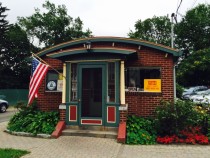By Mary Donohue
Since 1973, Historic Preservation Month has been celebrated in May. For New Englanders, this is a particularly welcome choice since spring has come and we can begin to appreciate the outdoors again. May reminds us of what we like about our communities, with beautiful dogwood trees in bloom, lively daffodils and delicate green leaves just beginning to appear on the tree limbs. Historic preservation events take place across the country encouraging us to appreciate our community’s landmarks—the buildings that tell our story.
At the time I chose to become a historic preservationist, large swathes of our country’s downtowns had experienced an era known as “Urban Renewal.” After the Second World War the federal government funded programs that demolished historic neighborhoods and downtowns to clear “slums” and encourage new construction. So many of the buildings that I thought of as special—downtown buildings that housed local businesses, my city’s oldest neighborhoods adjoining the downtown and a hundred years’ worth of architecture—disappeared in less than a decade’s time. My neighborhood, filled with picturesque early twentieth-century homes, experienced red-lining, block busting and every manner of disinvestment. During a summer job cataloging the photograph collection of our local museum, I was by turns dismayed, appalled and even angry about the beautiful buildings that had been demolished—their memory surviving only in a photograph or postcard.
But the tide began to turn. In 1961, Jane Jacobs published The Life and Death of Great American Cities, one of the first—and strongest—critiques of contemporary large-scale urban renewal. The National Historic Preservation Act was signed into law in 1966. The act had one rationale: the nation’s historical and cultural foundations should be preserved as living components of community life and development in order to provide the American people a sense of place and connectedness. Our historic buildings and neighborhoods were not to be preserved just as museums, but as vibrant repositories of our collective history.
Saving historic buildings allows us to connect to our community. Buildings often have multiple layers of meaning. Take 2 Mahl Avenue in Hartford. Built as a farmhouse about 1840 by a German immigrant when the city’s North End was still farmland, by the 1920s it housed an Orthodox Jewish synagogue. In the 1960s, an African American Masonic Lodge bought the building and continues to use it. This building portrays (in capsule form) the North End’s development from farmland to urban fabric and the accompanying sequence of ethnic changes making the history of this building significant to many individuals. Memories, traditions and historical events are anchored by the historic buildings where they occur.
How am I planning to celebrate Historic Preservation Month? I’m planning to hire a painter to spruce up the paint job on my 102-year-old house. I’m going to give a walking tour of my neighborhood and I’m going to meet a friend for coffee at the vintage diner down the street. My places are worth saving!
___________________________
Ms. Donohue has more than 30 years’ experience as an award-wining historic preservationist, architectural historian and author. She is the president of Grant House Heritage Services and is the Assistant Publisher of Connecticut Explored, the state’s history magazine.










